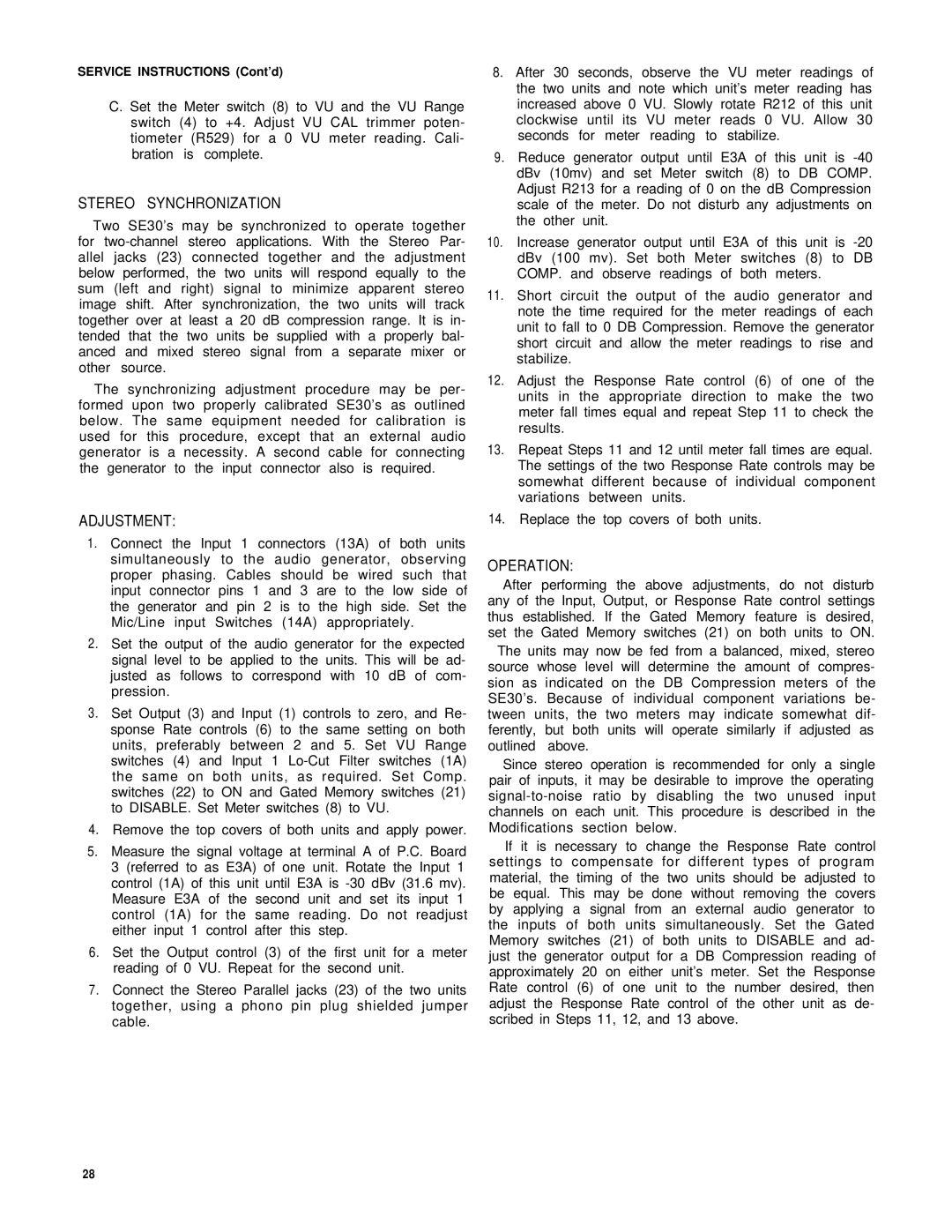SERVICE INSTRUCTIONS (Cont’d)
C. Set the Meter switch (8) to VU and the VU Range switch (4) to +4. Adjust VU CAL trimmer poten- tiometer (R529) for a 0 VU meter reading. Cali- bration is complete.
STEREO SYNCHRONIZATION
Two SE30’s may be synchronized to operate together for two-channel stereo applications. With the Stereo Par- allel jacks (23) connected together and the adjustment below performed, the two units will respond equally to the sum (left and right) signal to minimize apparent stereo image shift. After synchronization, the two units will track together over at least a 20 dB compression range. It is in- tended that the two units be supplied with a properly bal- anced and mixed stereo signal from a separate mixer or other source.
The synchronizing adjustment procedure may be per- formed upon two properly calibrated SE30’s as outlined below. The same equipment needed for calibration is used for this procedure, except that an external audio generator is a necessity. A second cable for connecting the generator to the input connector also is required.
ADJUSTMENT:
1.Connect the Input 1 connectors (13A) of both units simultaneously to the audio generator, observing proper phasing. Cables should be wired such that input connector pins 1 and 3 are to the low side of the generator and pin 2 is to the high side. Set the Mic/Line input Switches (14A) appropriately.
2. Set the output of the audio generator for the expected signal level to be applied to the units. This will be ad- justed as follows to correspond with 10 dB of com- pression.
3. Set Output (3) and Input (1) controls to zero, and Re- sponse Rate controls (6) to the same setting on both units, preferably between 2 and 5. Set VU Range switches (4) and Input 1 Lo-Cut Filter switches (1A) the same on both units, as required. Set Comp. switches (22) to ON and Gated Memory switches (21) to DISABLE. Set Meter switches (8) to VU.
4.Remove the top covers of both units and apply power.
5.Measure the signal voltage at terminal A of P.C. Board 3 (referred to as E3A) of one unit. Rotate the Input 1 control (1A) of this unit until E3A is -30 dBv (31.6 mv). Measure E3A of the second unit and set its input 1 control (1A) for the same reading. Do not readjust either input 1 control after this step.
6.Set the Output control (3) of the first unit for a meter reading of 0 VU. Repeat for the second unit.
7. Connect the Stereo Parallel jacks (23) of the two units together, using a phono pin plug shielded jumper cable.
8.After 30 seconds, observe the VU meter readings of the two units and note which unit’s meter reading has
increased above 0 VU. Slowly rotate R212 of this unit clockwise until its VU meter reads 0 VU. Allow 30 seconds for meter reading to stabilize.
9. Reduce generator output until E3A of this unit is -40 dBv (10mv) and set Meter switch (8) to DB COMP. Adjust R213 for a reading of 0 on the dB Compression scale of the meter. Do not disturb any adjustments on the other unit.
10.Increase generator output until E3A of this unit is -20 dBv (100 mv). Set both Meter switches (8) to DB COMP. and observe readings of both meters.
11.Short circuit the output of the audio generator and note the time required for the meter readings of each unit to fall to 0 DB Compression. Remove the generator short circuit and allow the meter readings to rise and stabilize.
12.Adjust the Response Rate control (6) of one of the units in the appropriate direction to make the two meter fall times equal and repeat Step 11 to check the results.
13.Repeat Steps 11 and 12 until meter fall times are equal. The settings of the two Response Rate controls may be somewhat different because of individual component variations between units.
14.Replace the top covers of both units.
OPERATION:
After performing the above adjustments, do not disturb any of the Input, Output, or Response Rate control settings thus established. If the Gated Memory feature is desired, set the Gated Memory switches (21) on both units to ON.
The units may now be fed from a balanced, mixed, stereo source whose level will determine the amount of compres- sion as indicated on the DB Compression meters of the SE30’s. Because of individual component variations be- tween units, the two meters may indicate somewhat dif- ferently, but both units will operate similarly if adjusted as outlined above.
Since stereo operation is recommended for only a single pair of inputs, it may be desirable to improve the operating signal-to-noise ratio by disabling the two unused input channels on each unit. This procedure is described in the Modifications section below.
If it is necessary to change the Response Rate control settings to compensate for different types of program material, the timing of the two units should be adjusted to be equal. This may be done without removing the covers by applying a signal from an external audio generator to the inputs of both units simultaneously. Set the Gated Memory switches (21) of both units to DISABLE and ad- just the generator output for a DB Compression reading of approximately 20 on either unit’s meter. Set the Response Rate control (6) of one unit to the number desired, then adjust the Response Rate control of the other unit as de- scribed in Steps 11, 12, and 13 above.
